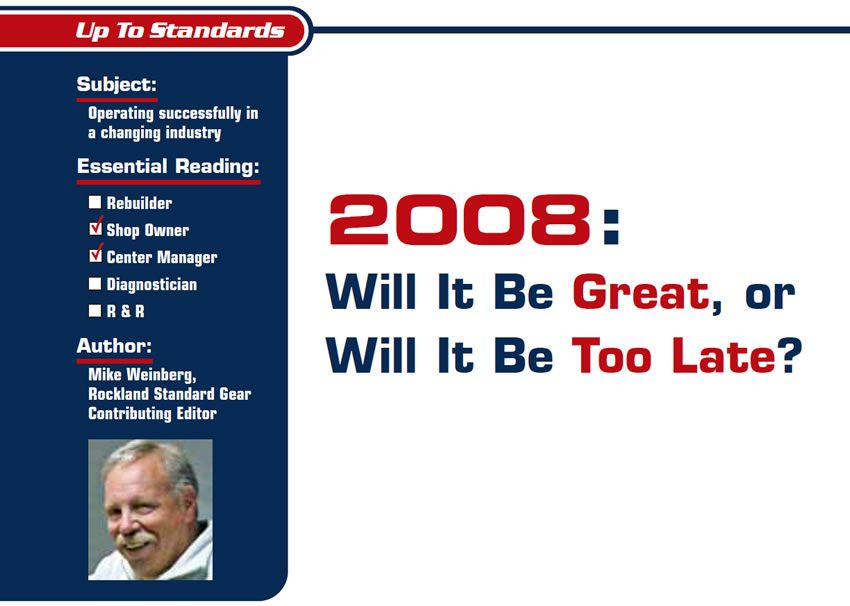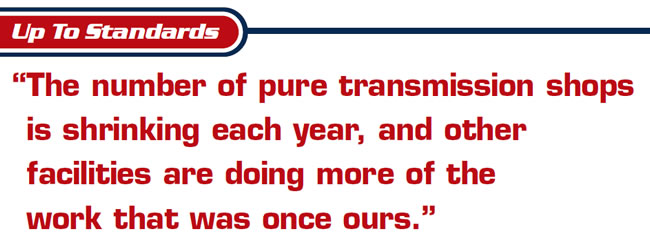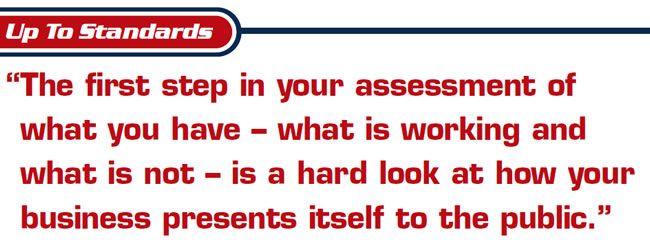
Up to Standards
- Subject: Operating successfully in a changing industry
- Essential Reading: Shop Owner, Center Manager
- Author: Mike Weinberg, Rockland Standard Gear, Contributing Editor
I have always believed that to be successful one must have a positive outlook on life. Whatever you do should be done with passion and excitement, and to the best of your ability. If you don’t enjoy what you are doing, it is time to make a change and get into something new. An old quote says, “If you love what you do, you will never work a day in your life.”
Our industry and the economy in general have been fighting an uphill battle for the past five years at least. I speak every day with shop operators who are struggling. Sales are way off, there is no work, nobody has money to spend etc. As we start a new year we need to create a business plan for the next 12 months that will drive us in the direction we can take to grow our industry and to survive the economic times ahead.
There is no question that the car manufacturers, no matter how much their sales are off, are building great products. The late-model cars definitely perform better and, even with longer warranties, have fewer failures under warranty. This, in turn, is seriously affecting the dealer network, in that the large percentage of service work they enjoyed doing warranty repairs for the factory is down considerably. For years buyers bought or leased vehicles every few years, and those cars and trucks did not come into independent shops because they were always under warranty.
This is now changing because of the current credit crunch and because many people have lived beyond their means and are now deep in debt and unable to buy or lease another new vehicle.
Typically our industry has done well in recessions because when “they can’t buy new, they fix what they have.” The government and the press are downplaying the current economic picture, but you can hardly rely on them for the truth. We have a Consumer Price Index that is supposed to chart the economic outlook using certain indicators. The politicians have removed food and fuel from those indicators as being “too volatile.” The CPI is now a joke, because food and fuel are items everyone has to buy on a daily basis.
Washington is totally disconnected from the ordinary citizen and considers us to be only cash cows, to be plucked for fees, taxes, assessments etc. as often as possible without a shred of accountability by our elected officials and bureaucrats on how they waste these funds. The purpose of this depressing paragraph is to make sure you understand that we are on our own, and unless we make some changes there is no one else to help or who really cares.
The first question you need to ask yourself is, “Do I wish to remain in this business?” If after some careful thought you answer in the affirmative, what are you going to change to make sure you remain profitable? The number of pure transmission shops is shrinking each year, and other facilities are doing more of the work that was once ours. There are many sources for reman transmissions, and the dealerships and general-repair shops are able to source quality reman units and do the installations.

How do we proceed with a business model that will carry us forward and be profitable? We start with being very honest about our abilities and our assets, and our shortcomings. A careful, honest analysis of your business will provide direction and the beginning of a plan. Any plan must address the desired outcome and make provision for failures and setbacks along the way. Setting priorities in a doable order is a must.
The first step in your assessment of what you have – what is working and what is not – is a hard look at how your business presents itself to the public. Does your facility look like a place you wish to visit? Is it clean and neat with a hospitable atmosphere that welcomes customers? Time have changed dramatically in our market and a great number of your customers are women. Men like machinery and gadgets; women like clean and neat people in uniforms, a nice waiting area and an attitude that establishes a comfort level in a strange and little-understood world.
We know that most male customers don’t have a clue about the workings of a transmission but won’t admit it, whereas the women are more honest. A small expense and a lot of careful effort will make your place one that women recommend to other women, which is a better return than all the dollars you will spend on advertising. If 50% or more of the people bringing vehicles to your shop are female, your sales approach and explanation of their problem have to be patient and thorough. It is time consuming, but an enlightened consumer is a happy customer. Be careful in making assumptions, and spell out the details clearly without patronizing the customer.
Advertising is next. Do you do any, and if you do is it providing returns on investment? You must track every inquiry to find out how that customer heard about you. There is little money around today for advertising, and you can’t afford to waste it. We get locked into traditions that have worked in the past but may not produce for you in today’s market.
Since most of your inquiries will come by phone, have you established a set of telephone procedures for everyone who may answer the phone? This is also advertising, where you start from the very first contact to establish a feeling of professionalism and trust with every caller. I hate to tell you how many shops I call regarding a tech-line message and the phone is answered “What?” No matter how busy you are, how hectic and crazy your day is, you cannot afford to let it transfer to a potential or current customer. How nice can you be to somebody who is going to give you several thousand dollars? Most of the callers will do just that if you can make them feel from the beginning that you are the person they want to give the money to.
Work flow needs to be examined. Do we have too few people, do we have too many people, are our people being used to maximize their abilities, are the right people in the right places? Are we using our available assets for the highest percentage of profit? The current field of transmissions with four, five, six or more speeds means that more time is spent on diagnostics, electronic issues and rebuilding than ever before. In the “good old days” a good rebuilder could turn out two or three units a day. Those days are long gone with the complexity of the average late-model units.

Know when to hold ’em, and know when to fold ’em. It is called asset allocation in the corporate world, which means to you that you should concentrate on building what you do well and perhaps buying reman units for those you see once in a while. Does it pay to tie up a good, productive builder on a one-off unit when he could give you two comeback-free units a day? Get your ego out of the way and concentrate on maximum profitability and larger gross profit. Remember that you pay for your education, one way or another, with time and money.
Charge correctly for your work. A great many shops give their work away, which immediately puts them on the path to ruin. It is OK to do a free fluid check and road test, but it is foolish not to charge for diagnostic work, especially when it involves electronics. If you explain to the customer the complexity of the system, the cost of the diagnostic tools and the training and talent of the people, an hourly charge for diagnosis becomes better understood.
Look at your profit margins and make sure they are high enough. Notice I did not say markup, as margin is very different from markup. If you wish to make a 50% margin on a part, you have to mark it up 100%. If you mark it up 40%, you will realize about 27% margin. You must be profitable enough to put all the money into the unit, build it right the first time and satisfy the customer. Every time you fail to do that you will lose more than you made, and some of the comebacks can be life threatening financially.
You need to invest in the right training and in the correct diagnostic tools and manuals. If you are not reading a couple of hours a day, you are falling behind. The technology is changing so fast that you must budget adequately for the correct tools and training to do the job. There are scan tools and computer programs available to us that give you everything the dealer has available. This is the only way you can compete with the dealer or hope to get some overflow work from the dealer. If you have the same tools and talent, and you can get the job done faster for the same or less money, you can make that sale.
There are still people out there trying to read codes in maybe six computers in one vehicle without the proper tools or manuals. Join one or more technical services or associations. The entry cost is minimal, and as a member you have a sophisticated group of experts who have a massive database of accumulated knowledge to help you get the job out the door.
Christopher Columbus and other explorers were the bravest of the brave, going where no one had been before. Unless you think breaking new ground all the time is profitable, it might be more efficient to ask directions. Continue your education in the theory of operations of the cars and trucks you work on. That understanding will make you very efficient and profitable.
You have now examined your business and arrived at a good assessment of what you do well and your profit structure. Eliminate those things that are not profitable or raise the cost to the consumer to make them profitable, and eliminate those services that consume time with no gain. Seek new niches in the market from which you can bring in more profit. You already have a physical plant and a staff that costs you a certain dollar amount every day. Find areas to maximize the use of that time to increase your profits.
Perhaps you should do general-repair work such as brakes, shocks, exhaust or suspension to create cash flow to match the unbilled time available. Performance and racing, off-road and four-wheel-drive repairs, differential work, antique and classic cars all provide a huge market for quality repair professionals. Every area is different, and you must examine your local area for niche markets that you can exploit.
Look for demand that is going unfulfilled. Is the nearest driveshaft shop far enough away for you to satisfy customers’ needs locally? Search for any areas in which you can provide service and meet the demand for work matching your own already-established abilities. Marine transmissions, commercial fleets, specialty needs for certain customers create a collection of niche markets that collectively will bring you solid growth in this changing market.
There is a huge market in tuning Japanese import cars for the youth market. These people spend money because they want to, as opposed to the customer who needs a repair but would do anything to get out of the job because it was not in their plans.
Resist the temptation to neglect alternative technologies. Electric cars, advanced diesel design, hydrogen fuel cells and more are coming. Embrace and learn the new designs, as they will surely break and malfunction and need repair. Put yourself in a position to get this work.
Once you have identified areas in which you can provide your customers new services to grow your business, you must now do the research to be qualified to perform profitably. This will not come overnight and will take a large investment of time to learn all the aspects of the new service. Make no mistake about it, nothing good comes easy or fast enough, but effort and persistence will let you expand your horizons. There are no alternatives if you wish to continue in business.
Those of you who remember the old days when parts were cheap and cores were easily available know that everything has changed. Gone are the days of having a number of people apply for jobs and having what seems like simple problems to correct. The work today demands excellence in diagnostic and electronic knowledge, plus an ever-expanding investment in tools and equipment. You have already made a very large commitment to your present business, and you now need to make a commitment to either change with the times or cease business.
As the number of shops declines, those operators who have become technically capable and learned to be good business managers will continue and succeed. The thinning numbers mean that even though the cars last longer there will be work for qualified people as always. Every economic situation provides opportunity for those who are sharp enough to locate them and turn them to an advantage.














